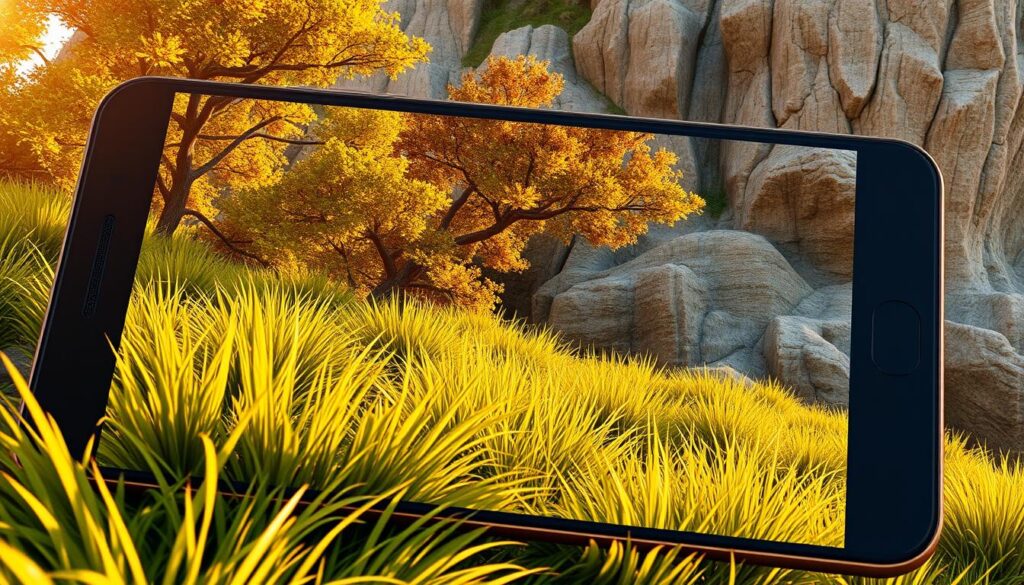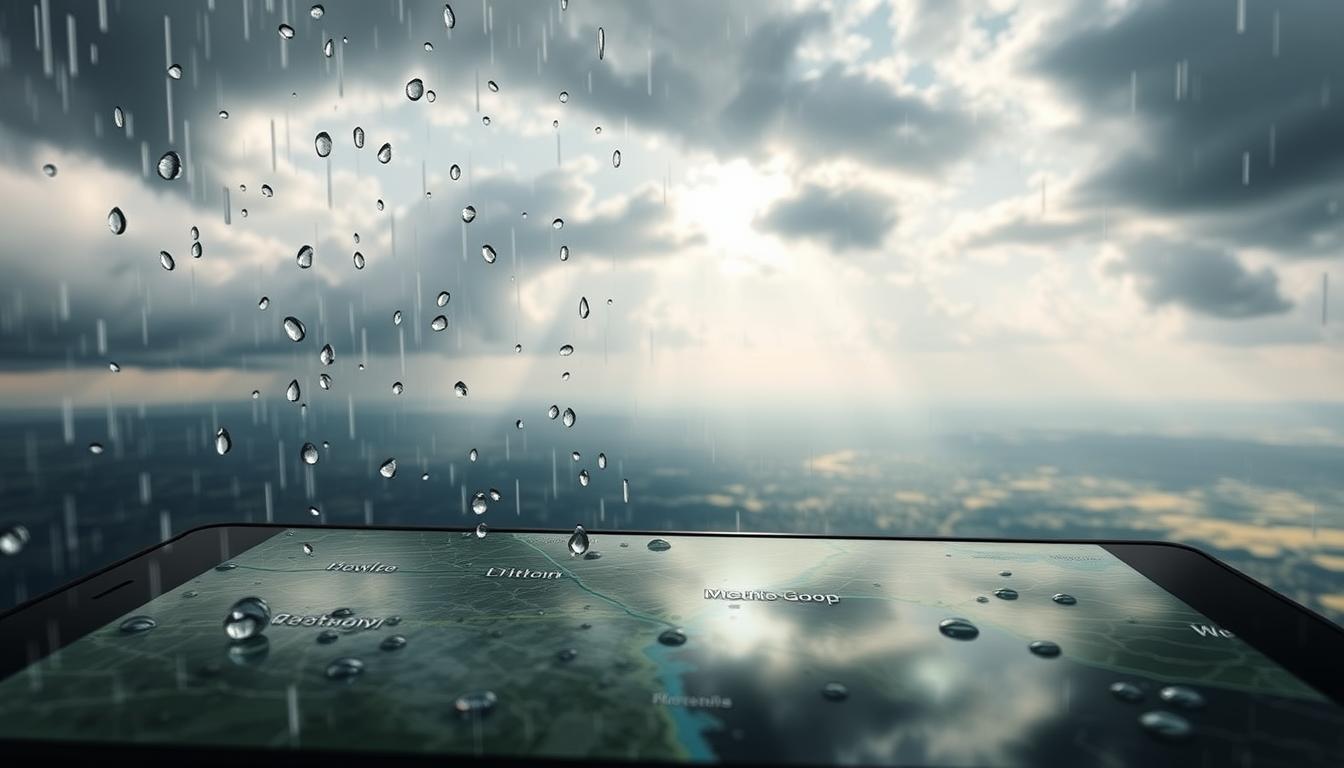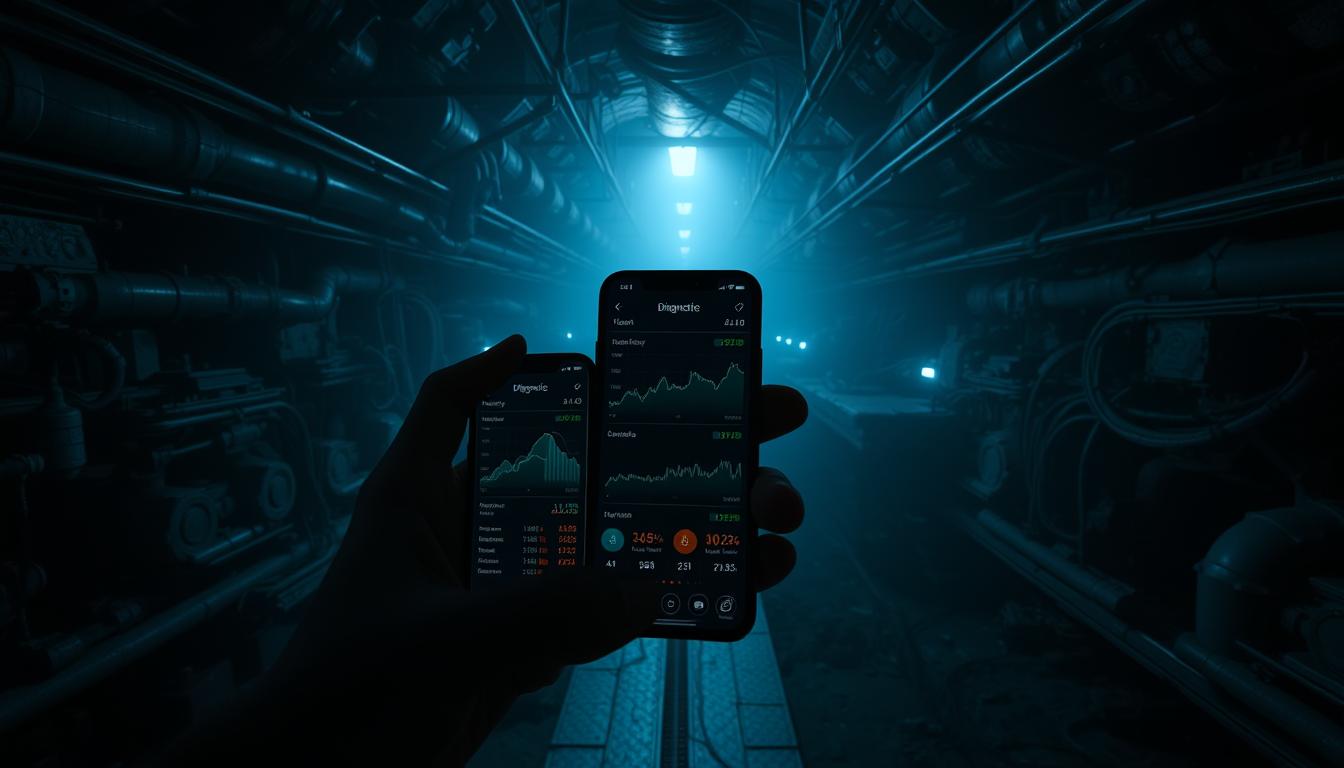Optimizing mobile gaming experiences might depend on mastering texture management. In today’s world, mobile apps need to perform well and look great. That’s why managing textures in Mobile Procedural Maps is key.
We’ll look at 3D Texturing Tools made for mobile apps. These tools help improve the quality and speed of your assets. Let’s dive into new ways to design mobile apps.
Introduction to Texture Management in Mobile Environments
Texture Management is key to better app performance on mobile devices. These devices have limited resources. So, we need to make textures efficient and look good.
For 3D Models, texture quality affects both looks and app speed. Bad texture management can slow down apps and upset users. It’s important to keep textures efficient for better app performance.
Using smart texture methods lets us add more detail to 3D Models. Techniques like texture atlases and adjusting resolution help. This way, we can make apps look great without using too much device power.

Understanding Procedural Maps in 3D Modeling
Procedural maps are a game-changer in 3D modeling. They let artists create textures using algorithms, boosting creativity and speed. This is a big change from the old way of making textures by hand, which took a lot of time and wasn’t always consistent.
Using procedural maps, creators get many benefits. These benefits make their work easier and better. They help make projects look and feel top-notch.
Definition and Benefits of Procedural Maps
Procedural maps are algorithms that make textures based on certain inputs. The main advantages of using them in 3D modeling are:
- Faster Production Times: Artists can make high-quality textures quickly, without spending hours on them.
- Consistency: Procedural maps make sure all assets look the same, which helps avoid differences.
- Resource Efficiency: These maps use very little space, which is great for projects with limited resources.
Use Cases in Mobile Gaming and Applications
In mobile gaming, procedural maps are key. They help make different and exciting environments without using too much power. Developers use them to create detailed landscapes, realistic weather, and complex patterns easily.
This way, mobile games stay fun and run smoothly. It’s all about keeping the game exciting and the performance up.

Key Challenges in Texture Management for Mobile Platforms
Managing textures on mobile devices is tough due to their limitations. It’s key for developers to know these challenges to improve app performance and user experience. This section talks about performance bottlenecks and texture memory issues that affect mobile apps.
Performance Bottlenecks in Mobile Devices
Mobile devices struggle with performance due to limited hardware. They have less processing power, slower GPUs, and less RAM. This slows down texture rendering, causing delays in loading and frame rates. To fix this, developers need to optimize textures for different mobile devices.
Texture Memory Limitations
Texture memory is a big problem on mobile platforms. Using too much memory can make apps slow, crash, or show visual problems. To solve this, developers should use smart texture management like atlases or mipmapping. Knowing the memory limits of each device is crucial for a smooth user experience.
Smart Texture Management in Procedural Maps
Managing textures well is key on mobile platforms, especially with procedural maps. Smart strategies make sure assets are used right without losing quality. This helps avoid common problems in mobile apps.
UV mapping is a big help. It projects a 2D image onto a 3D model’s surface. This lets developers apply textures more carefully. Done right, it boosts the look of procedural maps without slowing things down.
Texture atlases are another smart move. They combine many texture maps into one. This cuts down on draw calls, making things faster. It’s perfect for procedural maps, where many textures need to work together.
Procedural generation adds more to texture management. It makes textures automatically, so they look good on any device. This means even mobiles can handle detailed textures without running out of memory.
Using these methods improves looks and performance, which is vital for mobiles. Keeping up with optimization helps make apps better and more engaging for users.
Best Tools for 3D Texturing in Mobile Development
Choosing the right 3D texturing tools is crucial for mobile development. Many software options are available, each with special features for mobile use. Knowing what these tools can do helps developers make apps that look amazing.
Overview of Popular Software
Some tools are especially good for mobile development. Here are a few top picks:
- Adobe Photoshop – Known for its work in 2D and 3D, Photoshop is great for making and editing textures.
- Autodesk Mudbox – Perfect for sculpting and painting textures, Mudbox makes work easier and results better.
- Quixel Mixer – With Megascans, Mixer brings top-notch texturing, especially with Unreal Engine.
Criteria for Choosing 3D Texturing Tools
When picking 3D texturing tools, consider a few important things. This ensures they fit what mobile development needs:
| Criteria | Importance | Examples |
|---|---|---|
| Cost | How much you spend matters a lot | Subscription vs. one-time purchase tools |
| Compatibility | Tools need to work on different mobile platforms | Windows, macOS, and mobile-specific OS |
| Ease of Use | Easy-to-use tools help you work faster | Tutorial availability and community support |
| Supported Operating Systems | The tool should work well on the right systems | iOS, Android, and cross-platform tools |
Adobe Photoshop: A Staple for Texture Creation
Adobe Photoshop is a key tool for texture artists, especially for 3D models. Its easy-to-use interface and strong features make it perfect for making 2D textures. These textures are vital for making 3D environments look better.
Creating 2D Textures for 3D Models
Adobe Photoshop offers many tools for creating textures. Artists can use layers, adjust colors, and set up advanced brushes. This lets them make detailed 2D textures for 3D models.
They can also manipulate photos and paint digitally. This creates textures that make 3D models look more real in games and simulations.
Exporting and Compatibility Features
Exporting textures from Adobe Photoshop is easy. It supports formats like PNG and JPEG. This makes it simple to use these textures in different 3D modeling programs.
This compatibility helps designers work faster. They can quickly add textures to platforms like Blender, Unity, and Unreal Engine. This makes the whole production process smoother.
Autodesk Mudbox: Enhancing Workflow Efficiency
Autodesk Mudbox is a top tool for digital sculpting and texture painting. Its easy-to-use interface makes it perfect for artists who value Workflow Efficiency. It lets artists paint textures right on 3D models, making texturing faster.
The software’s retopology feature helps create clean polygon meshes. This is key for keeping 3D assets looking great. It also boosts performance, especially on mobile where saving resources is important. Autodesk Mudbox makes complex tasks easier, letting artists focus more on creativity.
In mobile game development, managing memory is key. Techniques like those in managing memory in mobile gameplay are vital. Autodesk Mudbox helps developers succeed in their projects.
Autodesk Mudbox is a go-to for 3D artists wanting to improve their Workflow Efficiency. It helps create amazing polygon meshes that make digital worlds come alive.
Quixel Mixer: Next-Level Texturing with Megascans
Quixel Mixer is a game-changer in texture management, thanks to Megascans. It makes creating realistic textures easy for mobile apps and games. With Megascans, Quixel Mixer offers a vast library of top-notch assets. This helps developers make their projects look amazing.
Features and Compatibility with Unreal Engine
Quixel Mixer’s standout feature is its multi-channel 3D painting. Artists can paint on 3D models with ease, using different textures and materials. It’s made for Unreal Engine, making it easy to use and import textures and materials.
The asset library with Megascans means developers have endless textures to use. This makes working on multiple projects a breeze.
Benefits of Using Smart Materials
Smart Materials in Quixel Mixer are a big plus for developers. They adjust automatically to the object’s details, saving time. This means faster work without losing quality.
Smart Materials also make creating complex textures quick. They handle layering and blending automatically. This is key in mobile development where time is precious. Using Quixel Mixer and Megascans together takes texture management to the next level, ensuring top-notch results.
| Feature | Description | Benefit |
|---|---|---|
| Multi-channel 3D Painting | Paint directly onto 3D models with multiple texture channels | Increases realism and texture quality |
| Compatibility with Unreal Engine | Seamless integration allows easy import and export | Streamlines workflow, reducing project time |
| Smart Materials | Dynamic materials that adapt to the model’s attributes | Speeds up texture application without losing detail |
ZBrush: A Tool for Detailed Object Texturing
ZBrush is a top choice for digital sculpting and object texturing. It’s known for its advanced features. Artists use ZBrush to add fine details to 3D models, making them look more real and appealing.
PolyPaint Technology is a key feature. It changes how textures are applied to models. This technology makes texturing easier and more effective.
PolyPaint Technology in Texture Management
PolyPaint Technology lets artists paint directly on a model’s surface. This means no need for UV maps or extra geometry. It brings several benefits:
- Direct Texture Application: Artists can add colors and details quickly, improving their work flow.
- High-Level Detail: It’s easy to create complex textures, capturing the object’s essence with accuracy.
- No Geometry Overhead: The process doesn’t require extra geometry, keeping the model organized and simple.
Using ZBrush and PolyPaint Technology makes texturing more straightforward. Artists can focus on their creativity, not technical issues.
Substance Painter: Industry Standard for Realistic Texturing
Substance Painter is a top choice for realistic texturing in 3D models. It offers advanced tools for many industries, like gaming and film. Artists use it to add life to their digital work.
Integration with Adobe Creative Suite
Substance Painter works well with Adobe Creative Suite. This makes it easy to move assets between apps like Photoshop and Illustrator. It helps artists create textures that tell stories and draw viewers in.
Assessing Texture Resolution and Optimization
Texture resolution is key for mobile app performance and looks. Choosing the right resolution for mobile assets is crucial. Textures that are too big can slow down devices.
It’s best to keep texture sizes under 2048×2048 pixels. This helps keep things looking good and loads faster.
Optimal Resolution Settings for Mobile Assets
Knowing the best texture resolution is important for developers. It affects both how things look and how well they run. Here’s a table with the best settings for different mobile uses:
| Use Case | Recommended Texture Resolution | Impact on Performance |
|---|---|---|
| Mobile Games | 1024×1024 – 2048×2048 | Balanced quality with improved frame rates |
| Augmented Reality | 512×512 – 1024×1024 | Less resource-intensive, better responsiveness |
| 3D Applications | 2048×2048 | Higher detail at the cost of significant performance |
Impact on Performance and Rendering Speed
Texture resolution affects how fast things render on mobile devices. Bigger textures mean longer load times and more lag. This is especially true for devices with weak graphics.
Optimizing texture resolution means making them smaller and choosing the right file format. JPEG or PNG can help keep things looking good while loading faster.
Implementing Texture Atlases for Improved Efficiency
Texture atlases are a key tool for mobile game developers. They combine many textures into one image. This cuts down on the number of draw calls, making games run smoother.
Using texture atlases helps developers save memory and improve game speed. This is especially important on mobile devices, where resources are limited.
To use texture atlases, developers follow a few steps:
- They pick the right textures to group together.
- They make a single image that holds all these textures without losing quality.
- They update the UV mapping for models to point to the new atlas.
Texture atlases do more than just save resources. They make animations smoother and games load faster. This is crucial for mobile games, where speed and smoothness matter a lot.
A well-made texture atlas can greatly improve how fast and clear a game looks.
| Aspect | Benefits of Texture Atlases |
|---|---|
| Draw Calls | Fewer draw calls lead to reduced CPU overhead. |
| Memory Usage | More efficient memory allocation improves performance. |
| Visual Quality | Better texture management maintains high-quality visuals. |
| Loading Time | Faster loading times enhance user experience in mobile apps. |
Texture atlases are vital for making mobile games better. They help games run faster and look great. As developers keep using these techniques, games will get even better, giving players a top-notch experience.
Leveraging PBR (Physically Based Rendering) Techniques
PBR Techniques make textures in mobile games look more real by showing how light acts on materials. They use different texture maps like albedo, normal, and roughness maps. This makes objects look more real and fit well in their surroundings.
Using Physically Based Rendering on mobile devices brings big benefits. It’s key for making games feel real, especially on phones. PBR makes textures look good in any light, keeping them looking sharp everywhere.
Many game makers use PBR in their work now. As phones get better, using PBR Tools gets easier. This way, games look better without slowing down. It makes games more fun to play, with amazing visuals.
PBR Techniques change how we manage textures. They help developers save time by making textures look the same everywhere. Using Physically Based Rendering is a big step forward for mobile games. It lets developers be more creative.
The Role of UV Mapping in Texture Management
UV Mapping is key in Texture Management. It lets us put 2D textures on 3D models well. The way we map textures affects how models look and perform on mobiles. A good UV Layout is vital for top texture quality and smooth mobile rendering.
Best Practices for UV Layout Efficiency
To get the best out of UV Layout, follow these tips:
- Packing Techniques: Use smart packing to save space in UV layouts. This means covering more area with textures for better quality.
- Uniform Density: Keep the texel density the same everywhere. This makes the model look good and improves texture quality.
- Overlapping UVs: Overlapping UVs can save space, especially for symmetrical objects. It keeps quality high without using too much memory.
- Use of Atlas Textures: Put many textures into one atlas. This cuts down on texture swaps, boosting mobile performance.
- Testing and Iteration: Test models often to spot texture issues. Make changes based on what you find to improve UV Mapping.
By using these methods, you can make your UV Layout better. This will improve the quality and efficiency of Texture Management in mobile apps.
Performance Metrics: Measuring the Success of Texture Management
Measuring the success of texture management in mobile apps is key. It involves using performance metrics. These metrics show how well textures are managed in an app. It’s important to balance texture quality and rendering performance.
Metrics like frame rates, load times, and memory usage are crucial. They help developers see if their texture management works well. Fast frame rates and quick load times mean textures are handled efficiently.
For instance, comparing different texture sizes or formats can show big differences. Using these metrics regularly helps teams improve their texture management.
Case Studies of Successful Mobile Procedural Maps
Looking at real-world examples shows how mobile procedural maps work well. By studying different cases, developers learn what tools and methods are best. These examples often show new ways to improve performance on mobile devices.
Analyzing Optimized Projects and Tools Used
Several projects are known for their use of advanced tools to improve mobile procedural maps:
- Project A: Used Substance Painter for detailed textures, making games run smoother on less powerful devices.
- Project B: Applied Unreal Engine’s tools, cutting down on loading times and memory use.
- Project C: Chose Quixel Mixer for live texture changes, boosting visuals without losing performance.
These examples highlight the success of mobile procedural maps and the need for the right tools. Each story shows different strategies and results, proving the link between planning and mobile texture optimization.
Conclusion
The world of smart texture management in mobile procedural maps is always changing. Developers need to use the latest tools and techniques to make their apps better. This not only boosts performance but also encourages creativity and new ideas in design.
Procedural maps are key for creating dynamic textures in mobile games and apps. They help developers tackle the special challenges of mobile platforms. By focusing on quality and efficiency, projects can look great and run smoothly.
Looking ahead, staying up-to-date with smart texture management trends is crucial for mobile developers. New tech means new chances to make apps more fun and interactive. Keeping up with the latest in procedural maps will lead to exciting results.
FAQ
What is smart texture management in mobile procedural maps?
Smart texture management uses special techniques and tools. It makes sure mobile apps run smoothly and look great. This is done by working within the limits of mobile devices.
Why is texture management essential for mobile gaming?
Texture management is key for mobile games. It affects how well the game runs and how it looks. It makes sure the game looks good without slowing down the device.
What are procedural maps in the context of 3D modeling?
Procedural maps are made by algorithms, not by hand. They help make games faster and more consistent. They’re great for creating different environments in mobile games.
What are the main challenges in texture management for mobile platforms?
The big challenges are performance issues and running out of texture memory. These problems can make games slow or crash.
What strategies are effective for smart texture management?
Good strategies include UV mapping and using texture atlases. Procedural generation is also helpful. These methods keep games looking good while running smoothly.
What tools are recommended for 3D texturing in mobile development?
Adobe Photoshop is great for 2D textures. Autodesk Mudbox is good for painting textures. Quixel Mixer uses Megascans for realistic textures. ZBrush and Substance Painter are also top choices.
How does Adobe Photoshop contribute to texture creation?
Adobe Photoshop is key for making 2D textures. It offers many export options. This makes it easier for texture artists to work.
What are the advantages of using Autodesk Mudbox?
Autodesk Mudbox has a user-friendly design. It has tools like retopology. This makes painting textures on 3D models easier.
How does Quixel Mixer leverage Megascans technology?
Quixel Mixer uses Megascans for realistic textures. It has multi-channel 3D painting and smart materials. It works well with Unreal Engine.
What is PolyPaint technology in ZBrush?
PolyPaint lets artists paint textures on 3D models. It adds detail without changing the model’s shape. This improves the texturing process.
Why is Substance Painter vital in the industry?
Substance Painter is known for making realistic textures. It works well with Adobe products. This makes it versatile for creating assets.
What are optimal texture resolution settings for mobile assets?
Keep texture resolutions under 2048×2048 pixels. This balances performance and quality on mobile devices.
How do texture atlases improve rendering efficiency?
Texture atlases combine textures into one map. This reduces draw calls and boosts efficiency. It’s especially good for mobile platforms.
What are PBR techniques and their benefits?
PBR techniques use multiple maps for better texture quality. They provide realistic lighting and improve performance in mobile games.
How does UV mapping contribute to effective texture management?
UV mapping is crucial for efficient layouts. It minimizes wasted space and boosts texture density. This optimizes quality and performance for mobile apps.
How can the effectiveness of texture management be measured?
Effectiveness is measured by performance metrics like frame rates and load times. It ensures a balance between quality and device capabilities.
Can you provide examples of successful mobile procedural maps?
Successful examples show various tools and strategies used by developers. They demonstrate how to optimize texture management in mobile games.




